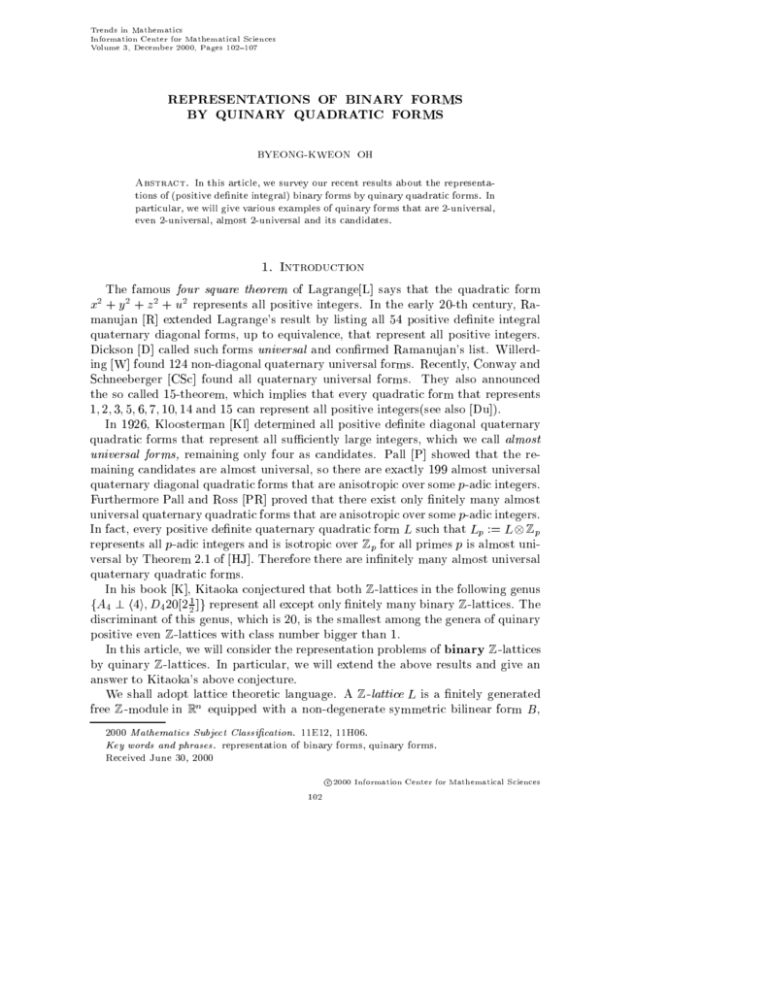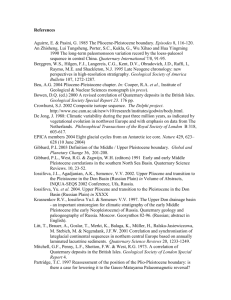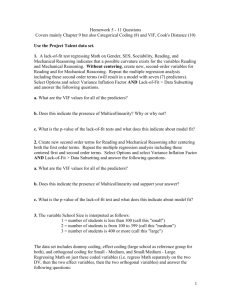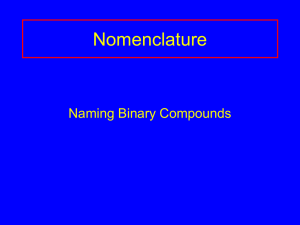REPRESENTATIONS OF BINARY FORMS BY QUINARY
advertisement

Trends in Mathematics
Information Center for Mathematical Sciences
Volume 3, December 2000, Pages 102{107
REPRESENTATIONS OF BINARY FORMS
BY QUINARY QUADRATIC FORMS
BYEONG-KWEON OH
Abstract. In this article, we survey our recent results about the representations of (positive denite integral) binary forms by quinary quadratic forms. In
particular, we will give various examples of quinary forms that are 2-universal,
even 2-universal, almost 2-universal and its candidates.
1. Introduction
The famous four square theorem of Lagrange[L] says that the quadratic form
x2 + y2 + z 2 + u2 represents all positive integers. In the early 20-th century, Ra-
manujan [R] extended Lagrange's result by listing all 54 positive denite integral
quaternary diagonal forms, up to equivalence, that represent all positive integers.
Dickson [D] called such forms universal and conrmed Ramanujan's list. Willerding [W] found 124 non-diagonal quaternary universal forms. Recently, Conway and
Schneeberger [CSc] found all quaternary universal forms. They also announced
the so called 15-theorem, which implies that every quadratic form that represents
1; 2; 3; 5; 6; 7; 10; 14 and 15 can represent all positive integers(see also [Du]).
In 1926, Kloosterman [Kl] determined all positive denite diagonal quaternary
quadratic forms that represent all suciently large integers, which we call almost
universal forms, remaining only four as candidates. Pall [P] showed that the remaining candidates are almost universal, so there are exactly 199 almost universal
quaternary diagonal quadratic forms that are anisotropic over some p-adic integers.
Furthermore Pall and Ross [PR] proved that there exist only nitely many almost
universal quaternary quadratic forms that are anisotropic over some p-adic integers.
In fact, every positive denite quaternary quadratic form L such that Lp := L Zp
represents all p-adic integers and is isotropic over Zp for all primes p is almost universal by Theorem 2.1 of [HJ]. Therefore there are innitely many almost universal
quaternary quadratic forms.
In his book [K], Kitaoka conjectured that both Z-lattices in the following genus
fA4 ? h4i; D4 20[2 21 ]g represent all except only nitely many binary Z-lattices. The
discriminant of this genus, which is 20, is the smallest among the genera of quinary
positive even Z-lattices with class number bigger than 1.
In this article, we will consider the representation problems of binary Z-lattices
by quinary Z-lattices. In particular, we will extend the above results and give an
answer to Kitaoka's above conjecture.
We shall adopt lattice theoretic language. A Z-lattice L is a nitely generated
free Z-module in Rn equipped with a non-degenerate symmetric bilinear form B ,
2000 Mathematics Subject Classication. 11E12, 11H06.
Key words and phrases. representation of binary forms, quinary forms.
Received June 30, 2000
102
c 2000 Information Center for Mathematical Sciences
REPRESENTATIONS OF BINARY FORMS BY QUINARY QUADRATIC FORMS
103
such that B (L; L) Z. The corresponding quadratic map is denoted by Q. Let
L be a Z-lattice. L is called even if Q(L) 2Z. We dene Lp := L Zp the
localization of L at prime p. If L admits an orthogonal basis fe1; e2 ; : : : ; eng, we
call L diagonal and simply write
L ' hQ(e1 ); : : : ; Q(en )i:
We always assume the following unless stated otherwise:
Every Z-lattice is positive denite.
The set of all Z-lattices K such that Lp = Kp for all primes p (including 1) is
called the genus of L, denoted by gen(L). The number of classes in a genus is called
the class number of the genus (or of any Z-lattice in the genus), which is always
nite. For any Z-lattice L, it is well known that every Z-lattice which is locally
represented by L is represented by some Z-lattices in the genus of L. Therefore if
the class number of L is 1, then the global representation can be reduced to the
local representation, which is completely known (see [O'M2]).
Let Pk be the set of all Z-lattices of rank k. For a Z-lattice L, we dene
Repn(k; gen(L)) := f` j `p ! Lp for all p; rank (`) = kg;
Repn(k; L) := f` j ` ! L; rank (`) = kg:
If Repn(k; gen(L)) = Pk , L is called locally k-universal and if Repn(k; L) = Pk , L
is called k-universal. If L is locally k-universal and jRepn(k; gen(L)) ; Repn(k; L)j
is nite up to isometry, L is called almost k-universal. The denitions of locally
even k-universal Z-lattice and even k-universal Z-lattice are similar to the above
ones. We set
a
b
[a; b; c] := b c
for convenience. For unexplained terminologies, notations, and basic facts about
Z-lattices, we refer the readers to O'Meara [O'M1] and Conway-Sloane [CS1,2].
2. (Even) 2-universal quinary Z-lattices
In 1930, Mordell [M] proved that I5 := x2 + y2 + z 2 + u2 + v2 can represent all
binary Z-lattices, that is, I5 is 2-universal. If a Z-lattice L is locally 2-universal
and has class number 1, then L is 2-universal as mentioned above. Note that every
quaternary Z-lattice cannot be 2-universal by a local property. The complete list
of 2-universal quinary Z-lattices are the following:
Theorem 2.1 [KKR],[KKO]. The number of 2-universal quinary Z-lattices is
11. They are:
I5 ; I4 ? A1 ; I4 ? h3i; I3 ? A1 ? A1 ; I3 ? A1 ? h3i; I3 ? A2 ;
I3 ? A1 10[1 21 ]; I2 ? A2 ? Ay1 ; I2 ? A2 ? h3i; I2 ? A3 ; I2 ? A2 21[1 31 ]:
In fact, all Z-lattices except K := I2 ? A2 ? A1 have class number 1, so the
proof of 2-universality is very easy. But the proof of 2-universality of K is a little
dicult (see [KKO]). As an analogue of Conway and Schneeberger's 15-theorem,
the following theorem can be proved:
104
BYEONG-KWEON OH
Theorem 2.2 [KKO]. A Z-lattice is 2-universal if and only if it represents the
following 6 binary Z-lattices:
h1; 1i; h2; 3i; h3; 3i; A2 ; A1 10[1 21 ]; A1 14[1 12 ]:
This is slightly dierent from 15-theorem in the following sense. The Z-lattice
h1; 2; 5; 5; 15i is 1-universal but it doesn't contain any quaternary 1-universal sublattice. But every 2-universal Z-lattice must contain one of 2-universal quinary
Z-lattices listed in Theorem 2.1.
In the remaining of this section, we consider only even Z-lattice. To nd all even
2-universal quinary Z-lattices, the following escalation method is very useful: Using
the binary Z-lattices which have small successive minima, for example A2 ; A1 ? A1 ,
determine the upper bounds of the successive minima of quinary Z-lattices to show
the niteness of even 2-universal quinary Z-lattices. For each Z-lattice, check the
locally even 2-universality of it by [O'M2] and exhibit all lattices satisfying the above
conditions up to isometry. Now among the remaining lattices, nd all Z-lattices
which have class number 1 by using the various tables such as [CS2],[N]. Clearly
these Z-lattices are even 2-universal. Lastly, for the other Z-lattices, either nd an
exceptional binary Z-lattice or prove the universality by using various techniques.
Theorem 2.3 [KO2]. All even 2-universal Z-lattices of rank 5 and the candidates
are the followings:
(i) Even 2-universal quinary Z-lattices
A5 ; D5 ; A1 ? D4 ; A1 ? A4 ; A2 ? A3 ; A2 ? A2 ? A1 ; A2 ? A1 ? A1 ? Ay1 ;
A3 ? A1 ? A1 ; A4 70[2 51 ]; A2 A2 24[11 13 ]; D4 12[2 21 ]; A1 ? A3 ?< 4 >;
A2 ? A2 30[1 13 ]y ; A1 ? A3 12[2 12 ]; A1 A3 44[11 41 ]; A1 A3 10[12 12 ]; A1 ? A3 20[2 12 ]y ;
A3 ? A1 14[1 21 ]y ; A1 A1 A2 84[111 16 ]; A2 ? A1 A1 12[11 21 ]; A1 ? A3 ?< 6 >y ;
A2 ? A1 ? A1 ?< 4 >y ; A1 ? A3 52[1 14 ]y ; [1; 1; ;1]; [2; 2; 0];
[01; 11; 1]; [01; 11; ;1]; [01; 01; ;1]y:
(ii) Candidates
A3 ? A1 22[1 21 ]; A1 A3 76[11 14 ]; A1 ? A1 ? A2 30[1 13 ]; A1 ? A1 A2 102[11 61 ];
A1 ? A1 A2 174[11 16 ]; A2 ? A1 A1 20[11 12 ]; A1 ? A2 ? A1 14[1 12 ];
A1 A1 A2 156[111 61 ]; [0; 1; 2]; [0; 2; 1]; [1; 2; 0]; [00; 01; 2]; [00; 10; 2];
[00; 11; 0]; [00; 11; 1]; [00; 11; 2]; [01; 10; 2]; [10; 11; 0]; [11; 11; 1]; [01; 0];
[01; ;1]; [00; 0]; [00; 1]; [00; 2]; [10; 0]; [11; 1]:
The notations of each Z-lattice are given by [CS1,2] and [O1]. In (i), the class
number of the Z-lattice with y-mark is bigger than 1 and all candidates are locally
even 2-universal Z-lattice with class number bigger than 1.
REPRESENTATIONS OF BINARY FORMS BY QUINARY QUADRATIC FORMS
105
3. Almost 2-universal quinary Z-lattices
Let L be an almost 2-universal quinary Z-lattice. Clearly L is locally 2-universal
and represents primitively all positive integers. The following lemma is very useful
to show whether a quinary Z-lattice is almost 2-universal or not.
Lemma 3.1 [O3]. Let L be any locally 2-universal Z-lattice of rank 5 and for all
prime p, let d(Lp ) = pup p , where p is a unit in Zp and up is a non-negative
integer. Then there exists a prime p dividing 2dL such that L cannot primitively
represent binary Z-lattices ` of the form
`p ' hpp p ; pk p i;
where p is 0 or 1, respectively the parity of up , p is any unit in Zp and k 2 if
p is odd and k 7 otherwise.
Therefore L represents all binary Z-lattices ` satisfying the above property. From
these conditions, one can prove the following theorem, which is quite dierent from
the rank 1 case.
Theorem 3.2 [O3]. The number of almost 2-universal quinary Z-lattices is nite.
Now we consider diagonal quinary Z-lattices. As a natural generalization of
Halmos' result [H], Hwang [Hw] proved that there are exactly 3 quinary diagonal
Z-lattices that represent all binary Z-lattices except only one.
Theorem 3.3 [O3]. All of diagonal almost 2-universal quinary Z-lattices and its
exceptions are the followings:
(i) 2-universal Z-lattices
h1; 1; 1; 1; ai a = 1; 2; 3;
h1; 1; 1; 2; bi b = 2; 3:
(ii) Almost 2-universal quinary Z-lattices and its exceptions
h1; 1; 1; 2; 4i : [3; 0; 3]
h1; 1; 1; 2; 5i : [3; 0; 3];
h1; 1; 2; 2; 3i : [2; 1; 2];
(iii) Candidates
h1; 1; 1; 1; 5i : [2; 1; 4]; [4; 1; 4]; [8; 1; 8];
h1; 1; 1; 2; 7i : [3; 0; 3]; [6; 0; 6];
h1; 1; 2; 2; 5i : [2; 1; 2]; [2; 1; 4]; [4; 1; 4]; [8; 1; 8]:
h1; 1; 1; 3; 7i; h1; 1; 2; 3; 5i; h1; 1; 2; 3; 8i:
As an answer of the Kitaoka's question, we proved the following:
Theorem 3.4 [KKO2].
For two Z-lattices in the following gen(A4 ? h4i) =
fA4 ? h4i; D4 20[2 21 ]g, the former represents all binary even Z-lattices except [4; 2; 4]
and the latter represents all except [2; 1; 4]; [4; 1; 4], and [8; 1; 8].
In [KKO2], there are various examples of representations of binary Z-lattices
by some particular quinary Z-lattices with class number 2. To prove the (almost)
106
BYEONG-KWEON OH
2-universality of each Z-lattice, some particular methods are needed for each Zlattice. As an example, we show that L = A2 ? A2 30[1 31 ] is even 2-universal. Let
` be any binary even Z-lattice. Since A?4 in E7 is A2 30[1 31 ],
` ! L if and only if A4 ? ` ! E7 ? A2 :
Note that
gen(E7 ? A2 ) = fE7 ? A2 ; E8 ? h6ig:
We can easily show that if A4 ? ` ! E8 ? h6i, then A4 ? ` ! E7 ? A1 ? h6i !
E7 ? A2 by considering the local property (see also [O1]). Therefore L is even
2-universal.
As a renement of Hsia, Kitaoka and Kneser's result [HKK], Jochner [J] proved
that every Z-lattice L of rank 6 can represent all binary Z-lattices that are locally
represented by L and whose minimum is suciently large. We give some quinary
Z-lattices satisfying these properties. Let L be a quaternary Z-lattice with class
number 1. For a positive integer k, we dene
L(k) := L ? hki;
where = 1 if L is odd, and = 2 if L is even.
Theorem 3.5 [KO1]. Assume that d := dL(k) is a (odd, if = 1) squarefree
integer. Let ` be a binary Z-lattice such that
`p ! L(k)p
primitively at all p. Then for any > 0, there exists a constant C > 0 depending
only on such that
if min(`) > C d 5+ ; then ` ! L(k):
Furthermore, the primitive condition cannot be omitted.
Remark. For n 3, see [O2] for n-universal Z-lattices with minimum rank. See
also [CKR] for totally positive ternary 1-universal OK -lattices, where OK is the
ring of integers of real quadratic eld K .
[CKR]
[CS1]
[CS2]
[CSc]
[D]
[Du]
[H]
References
W. K. Chan, M.-H. Kim and S. Raghavan, Ternary universal integral quadratic forms
over real quadratic elds, Japanese J. Math. 22 (1996), 263-273.
J. H. Conway, N. J. A. Sloane, Sphere packings, lattices and groups, Third Edition,
Springer-Verlag, 1999.
, Low dimensional lattices. I. Quadratic forms of small determinant, Proc.
Royal. Soc. London Ser. A 418 (1988), 17-41.
J. H. Conway and W. Schneeberger, A 15-theorem for universal quadratic forms,
preprint.
L. E. Dickson, Quaternary quadratic forms representing all integers, Amer. J. Math.
49 (1927), 39-56.
W. Duke, Some old problems and new results about quadratic forms, Notices in AMS
44 (1999), 190-196.
P. R. Halmos, Note on almost-universal forms, Bull. Amer. Math. Soc. 44 (1938),
141-144.
REPRESENTATIONS OF BINARY FORMS BY QUINARY QUADRATIC FORMS
[HJ]
[HKK]
[Hw]
[J]
[K]
[KKO]
[KKO2]
[KKR]
[Kl]
[KO1]
[KO2]
[L]
[M]
[N]
[O1]
[O2]
[O3]
[O'M1]
[O'M2]
[P]
[PR]
[R]
[W]
107
J. S. Hsia, M. Jochner, Almost strong approximations for denite quadratic spaces,
Invent. Math. 129 (1997), 471-487.
J. S. Hsia, Y. Kitaoka and M. Kneser, Representations of positive denite quadratic
forms, J. Reine Angew. Math., 301 (1978), 132-141.
D. Hwang, On almost 2-universal integral quinary quadratic forms, Ph. D. Thesis,
Seoul National Univ., 1997.
M. Jochner, On the representation theory of positive denite quadratic forms, Contem.
Math. 249 (1999), 73-86.
Y. Kitaoka, Arithmetic of quadratic forms, Cambridge Univ. Press, reprint with corrections, 1999.
B. M. Kim, M.-H. Kim, B.-K. Oh, 2-universal positive denite integral quinary quadratic forms, Contemporary Math. 249 (1999), 51-62.
M.-H. Kim, J.-K. Koo and B.-K. Oh, Representations of binary forms by certain
quinary positive integral quadratic forms, to appear in J. Number Theory.
B. M. Kim, M.-H. Kim and S. Raghavan, 2-universal positive denite integral quinary
diagonal quadratic forms, Ramanujan J. (1997), 333-337.
H. D. Kloosterman, On the representation of numbers in the form ax2 + by2 + cz 2 + dt2 ,
Acta Math. 49 (1926), 407-464.
M.-H. Kim, B.-K. Oh, A local-global principle for representations of binary forms by
certain quinary forms, Submitted.
, Even n-universal Z-lattices, In preparation.
J. L. Lagrange, Oeuvres 3 (1869), 189-201.
L. J. Mordell, Quart. J. Math. Oxford 1 1 (1937), 276-288.
G. L. Nipp, http://www.research.att.com/njas/lattices/nipp5.html.
B.-K. Oh, On universal forms, Ph. D. Thesis, Seoul National Univ., 1999.
, Universal Z-lattices of minimal ranks, Proc. Amer. Math. Soc. 128, 683-689.
, Extension of a problem of Kloosterman to lower ranks, Submitted.
O. T. O'Meara, Introduction to quadratic forms, Springer-Verlag, 1973.
, The integral representations of quadratic forms over local elds, Amer. J.
Math. 80 (1958), 843-878.
G. Pall, The completion of a problem of Kloosterman, Amer. J. Math. 68 (1946),
47-58.
G. Pall, A. Ross, An extension of a problem of Kloosterman, Amer. J. Math. 68 (1946),
59-65.
S. Ramanujan, On the expression of a number in the form ax2 + by2 + cz 2 + dw2 ,
Proc. Cambridge Phil. Soc. 19 (1917), 11-21.
M. F. Willerding, Determination of all classes of (positive) quaternary quadratic forms
which represent all positive integers, Bull. Amer. Math. Soc. 54 (1948), 334-337.
School of Math., Korea Institute for Advanced Study, Seoul 130-012, Korea
E-mail address :
bkoh@math.kias.re.kr
![Monuments [slide] by Gail Mary Busch](http://s2.studylib.net/store/data/013509404_1-cc3fa2527e23f488f537eaa874096e7e-300x300.png)


